How To Identify and Get Rid of Lawn Pests
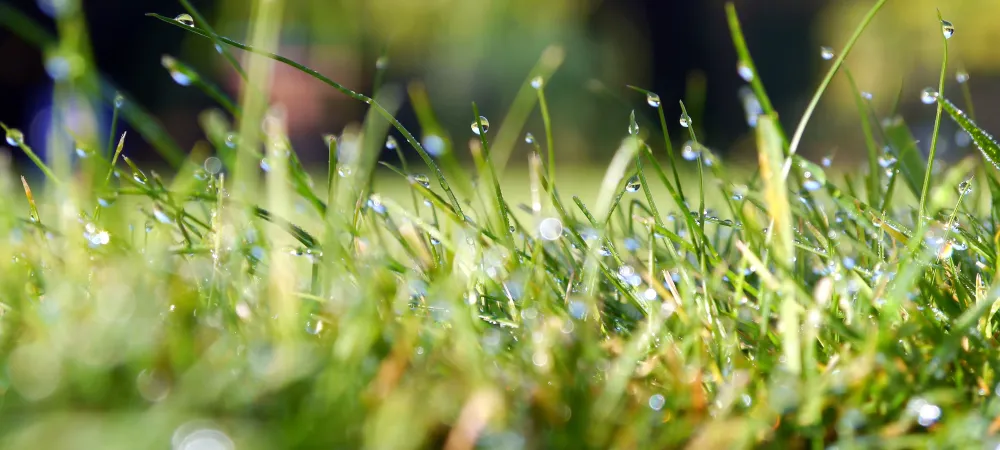
Maintaining a lush, green lawn is a source of pride for many homeowners. However, the battle against lawn pests is an ongoing challenge. In this comprehensive guide, we will explore some common lawn pests, their identification, life cycles, and effective ways to keep your lawn pest-free.
The most common types of lawn pests include:
Leather Jacket
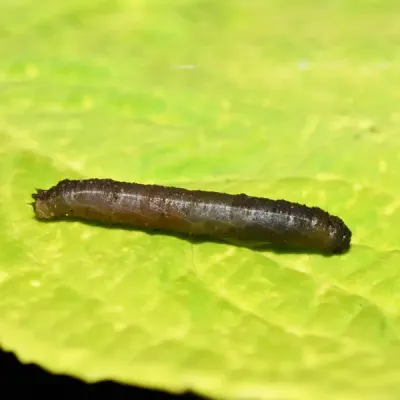
- Identification: Leather jackets are grayish-brown, legless larvae with a smooth, tough, leather-like exterior. They have a cylindrical body and are about 1 to 2 inches long. They are the larvae stage of the Crane Fly, which resembles a large mosquito, measuring about 1 inch long and brownish in color—though this bug is not dangerous and will not bite
- Life Cycle: Crane flies lay several hundred oval block eggs in moist turf soil. When the eggs hatch, the larvae (Leather Jackets) can cause severe damage to all types of grasses, feeding on the roots and grass leaves
- Leather Jacket Damage: Leather jackets feed on grass roots, causing patches of dead or dying grass. Lawns infested with these larvae may show signs of wilting, yellowing, and a general decline in overall turf health.
How To Get Rid of Leather Jacket Larvae
For leather jackets, introduce natural predators like nematodes, birds, or predatory beetles for biological control. Applying beneficial nematodes to the soil can parasitize and kill leather jacket larvae. Additionally, cultural practices such as maintaining a healthy lawn through proper watering, mowing, and aeration help minimize vulnerability to leather jackets. Early spring and fall are the best times to control them.
White Grubs
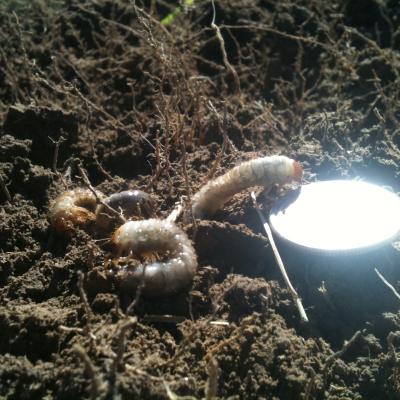
- Identification: White grubs are the larval stage of beetles, particularly the June Beetle, Japanese Beetles, and slightly smaller European Chafer. The C-shaped larvae have a creamy white body, a brown head, and six legs and are typically around 1 inch in length.
- White Grub Damage: Grubs feed on the roots of many plants but prefer the fibrous roots of turf grasses. As the root system gets destroyed, sections of the turf begin to wilt and turn brown. Affected areas exhibit wilting, browning, and an overall lawn thinning. Damaged turf may feel spongy when walked on.
The grass can often be picked right off the soil because there is little or no root system to hold it in place. Skunks will often do additional damage by digging up the lawn and searching for white grubs to feed on.
How To Get Rid of White Grubs
To combat white grubs, consider applying beneficial nematodes to the soil for biological control. Chemical insecticides labeled for grub control can also be used following recommended guidelines. Cultural practices such as keeping the lawn well-watered and aerated contribute to a healthier grass, making it more resistant to white grub damage.
Because grubs live in the soil and insecticides tend to bind to organic matter, grubs are hard to eliminate completely using chemical controls. In fact, each treatment generally only destroys approximately 50% of the grub population—but this is actually sufficient to stop damage to the turf. A lawn can still thrive while hosting up to 3-5 grubs per square foot because, at that rate, the grass can regrow its roots as fast as the grubs can eat it.
Chinch Bug
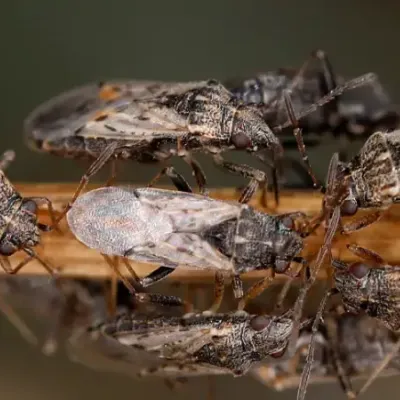
Chinch bugs are the most common pest we encounter and can wipe out an entire lawn in only six weeks.
- Identification: Adult chinch bugs are small, about 1/6 inch long, with black bodies and white wings folded over their backs. Nymphs are smaller and range from red to orange in color.
- Life Cycle: The first eggs hatch into nymphs in late May to early June. They then undergo 6 stages (instars) before becoming adults, during which time they do the most damage. In September the adults begin migrating out of their feeding areas and begin looking for overwintering sites. The adults have either full-wing development, which means they can migrate a few blocks away, or partial-wing development, which means they migrate to flower beds, shrubs, and trees.
- Chinch Bug Damage: Chinch bugs pierce grass blades with their mouthparts and feed on plant juices, causing yellowing, wilting, and eventually death of the grass. Damage typically starts in sunny areas and can spread throughout the lawn.
How To Get Rid of Chinch Bugs
For chinch bugs, insecticidal soaps or oils can be used on small infestations of nymphs. Chemical insecticides labeled for chinch bug control can be applied to affected areas. Additionally, cultural practices such as regular mowing and watering contribute to reducing chinchbug populations. Because the chinch bugs live in the thatch of the lawn, they are relatively easy to control.
Sod Webworm
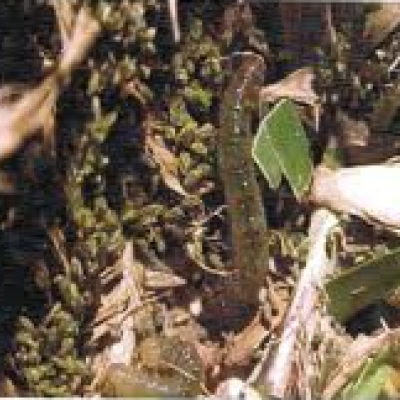
- Identification: Sod webworm larvae are small caterpillars with a cylindrical body, ranging from light tan to greenish-brown. Adult lawn moths are small and have a wingspan of about 1/2 to 3/4 inch, with a long snout, flying in a zigzag pattern when disturbed.
- Life Cycle: Adults randomly drop eggs on grass, which hatch into larvae. The larvae build silk burrows in the thatch, emerging at night to feed on grass leaves. There are 2 to 3 generations per year, and each generation will produce more adults. The population becomes cumulative - therefore, the worst damage is generally in the fall.
- Sod Webworm Damage: The sod webworm builds a silk burrow in the thatch and comes out at night to feed. It chews off grass leaves and drags them into their burrows, feeding on the grass. When feeding, webworms create irregular brown patches on lawns. Infestations can lead to extensive damage, with affected areas resembling drought-stressed turf. The presence of silk-lined tunnels is a telltale sign.
How To Get Rid of Sod Webworm
To control sod webworms, consider applying Bacillus thuringiensis (Bt) products for biological control. Chemical insecticides labeled for sod webworm control can also be used. Cultural practices, including maintaining a well-kept lawn and promoting natural predators like birds, help control sod webworm infestations.
Turfgrass Scale
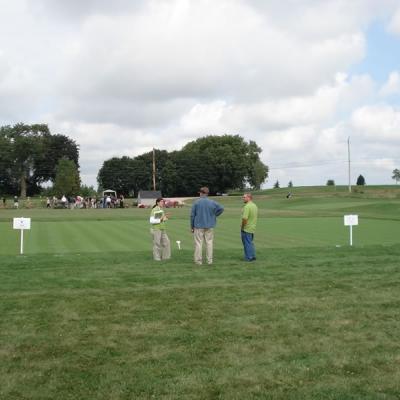
- Identification: Turfgrass scale insects are tiny, oval-shaped, and often have a protective waxy covering. They can range in color from brown to yellow or reddish-brown.
- Life Cycle: Native to Europe but recently introduced into Ontario, adult turfgrass scales lay up to 400 eggs in June, hatching into small red crawlers in July. The insect turfgrass scale has three instars, with the third instar overwintering in the soil as a salmon-pink bundle.
- Turfgrass Scale Damage: Turfgrass scale insects suck sap from grass blades, resulting in yellowing, stunted growth, and an overall decline in turf health. Heavy infestations can lead to significant damage, and the waxy covering protects them from predators.
How To Get Rid of Turfgrass Scale
To address turfgrass scale, apply horticultural oil to suffocate scale insects. Insecticidal soap is another option for controlling scale infestations. Cultural practices such as promoting a healthy lawn through proper fertilization and watering contribute to reducing susceptibility to turfgrass scale.
Black Cutworm
- Identification: Black cutworm larvae are smooth-skinned caterpillars with a greasy appearance, ranging from gray to black. They can grow up to 2 inches in length. It is the larval stage of a large moth that migrates from the United States each spring. It has black dots on each body segment and a strip along its length.
- Life Cycle: Eggs laid in spring hatch into cutworms that feed on grass leaves, sometimes cutting off grass plants without consuming them.
- Black CutwormDamage: The black cutworm comes out from its soil burrow at night to feed on the grass leaves. It may also cut off grass plants without feeding on them adding to their destructive nature. It is usually isolated to small areas within the lawn, but these small areas can be extensively damaged.
Black cutworm larvae cut off young grass plants near the soil surface, causing small, irregular dead patches in the lawn. Affected areas may appear as if they have been mowed unevenly. Damage is most prominent during the spring and early summer.
How To Get Rid of Black Cutworm
For black cutworms, encourage biological control by promoting natural predators like ground beetles, parasitic wasps, and birds. Apply chemical insecticides labeled for black cutworm control when necessary. Additionally, cultural practices, such as monitoring and controlling weeds, are crucial as black cutworms often lay eggs on or near weed hosts.
Professional Lawn Pest Control
Understanding the identification, life cycles, and control measures for common lawn pests is crucial for maintaining a healthy and vibrant lawn. Regular monitoring and early intervention are key to preventing extensive damage and ensuring your lawn remains an inviting and enjoyable space.
Between identifying different lawn pests and creating the most effective treatment plan, it is best to consult with a lawn care specialist. Our teams at Enviro Masters Lawn Care are here to provide tailored solutions for your lawn insect infestation. Contact our experienced technicians today to schedule your lawn inspection!
